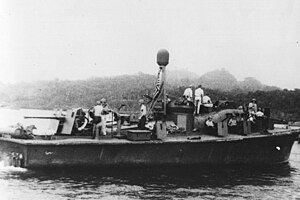 PT-59 after conversion into a gunboat, October 1943
| |
| History | |
|---|---|
| Name | PT-59 |
| Builder | Electric Launch Company, Bayonne, New Jersey |
| Laid down | 26 July 1941 |
| Launched | 8 October 1941 |
| Completed | 5 March 1942 |
| Fate | Sold, 1947, Sunk, 1976, remains raised and on display at Battleship Cove |
| General characteristics [1] | |
| Class and type | Elco 77-foot PT boat |
| Displacement | 40 long tons (41 t) |
| Length | 77 ft (23 m) |
| Beam | 19 ft 11 in (6.07 m) |
| Draft | 4 ft 6 in (1.37 m) |
| Propulsion | 3 × 1,500 shp (1,119 kW) Packard V12 M2500 gasoline engines, 3 shafts |
| Speed | 41 knots (76 km/h; 47 mph) |
| Complement | 15 as built, 18–20 as PT gunboat |
| Armament |
|
| Armor | Gunboat on gunwales, gas tanks |
| Service record | |
| Commanders: |
|
PT-59 / PTGB-1 was an S-Class Patrol Torpedo boat (PT boat) of the United States Navy, built by the Electric Launch Company of Bayonne, New Jersey. The boat was laid down as Motor Boat Submarine Chaser PTC-27, and was reclassified as BPT-11 when assigned to transfer to Britain under Lend-Lease. However, this was cancelled, and she was reclassified as PT-59 prior to launch on 8 October 1941, and was completed on 5 March 1942.[1]
After serving in a training squadron in Rhode Island, PT-59 was reassigned to the protection of the Panama Canal before being transported by oceangoing ship to the Solomon Islands in the South Pacific. It arrived at its home base of Tulagi and served successfully, sinking a Japanese submarine by torpedo.
In the fall of 1943, PT-59 was converted into a gunboat under the direction of its new commander, Lieutenant (and future U.S. President) John F. Kennedy when the chronic inaccuracy of the era's torpedoes and under-arming of the resulting craft were both recognized. She had all four of her torpedo tubes removed, as well as her two depth charges, but retained two 40-millimeter Bofors cannon anti-aircraft guns fitted fore and aft. The refit also added six .50-caliber machine gun nests, with three on each side, behind shields, as well as additional weaponry.
The partially armored craft was then notably used to rescue marines stranded under heavy Japanese gunfire on Choiseul Island, and attack both Japanese barges and shore batteries.
- ^ Hamilton 1992, p. 610.